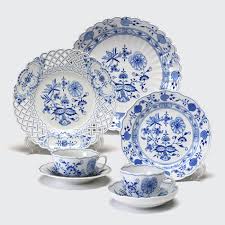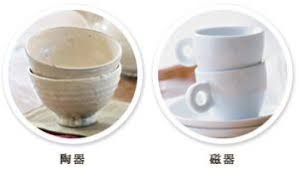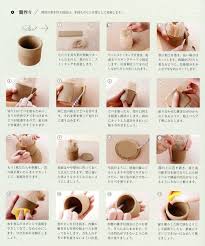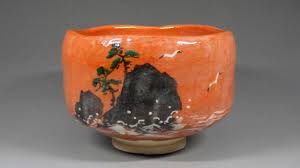Tojiki 陶磁器
What is tojiki ? 陶磁器って何だろう?

Tojiki refers to both toki, or pottery, and jiki, or porcelain,. Pottery making started in Japan in the 8th century, when the use of glaze was introduced. Meanwhile, porcelain production in Japan was started by a Korean potter in the early 17th century in Arita in today`s Saga Prefecture.
陶磁器は、陶器と磁器の両方を指します。陶器の製造は、日本では、釉薬が伝えられた8世紀に始まりました。一方、磁器の製造は、17世紀初期に朝鮮の陶工によって現在の佐賀県の有田で始められました。
How is Japanese porcelain different from European porcelain ? 日本の磁器はヨーロッパの磁器とどう違うの?

European porcelain developed in Germany, copying after pieces produced in China and Japan. In the process of finding the proper materials, they tried adding bone powder to the clay. Even after finding kaolin, the real porcelain material, they continued to add bone powder. That`s why European porcelain is called bone china.
ヨーロッパの磁器は、日本産や中国産の磁器を模倣しながらドイツで発達しました。正しい材料を探す過程で、試しに骨の粉を粘土に加えました。磁器の本当の材料であるカオリンが見つかった後も、骨の粉を入れ続けました。それゆえヨーロッパの磁器はボーンチャイナと呼ばれています。
What is the difference between pottery and porcelain ? 陶器と磁器はどう違うの?

The basic difference is the materials. Pottery uses fine clay, while porcelain uses porcelain stone known as kaolin. The firing temperatures for porcelain are usually higher than those by pottery. As a result of these differences, porcelain looks a bit translucent, and has hard and smooth textures, while pottery looks opaque, and has a coarse texture.
基本的な違いは材料です。陶器はきめの細かい土を使いますが、磁器はカオリンと呼ばれる陶石を粉にしたものを使います。焼成温度は、普通磁器の方が陶器より高くなっています。こういった違いから、磁器はやや半透明で手触りが堅くて滑らかなのに対して、陶器は不透明で手触りがザラザラしています。
How are pottery and porcelain made ? 陶器や磁器はどうやって作られるのですか?

Their manufacturing processes are basically the same. First, the materials are mixed with water and kneaded into desired shapes often using a wheel. They are fired and then underglaze paintings are made on the surface. After being glazed, they are baked again to finish. If necessary, overglaze paintings may be made and fired again to stabilize the pigment.
作り方は基本的には同じです。最初に原料を水と混ぜて、こねて好みの形にします。ろくろを使うことが多いです。それを焼いて表面に下絵付けをします。釉薬をかけた後、再度焼き上げて完成です。必要であれば、上絵付をして、顔料を定着させるためにもう一度焼くことがあります。
What are some of the ceramics unique to Japan ? 日本独特の焼物にはどんなものがありますか?

I think Raku ware is unique. Raku pieces are formed by hand without using a wheel, so they are a little deformed and look asymmetrical. Because of their natural shapes, Raku tea bowls better fit the palm when held. Another unique brand is Oribe, which was produced in the early 17th century. Oribe pieces are characterized by their distorted shapes and distinctive greenish color.
楽焼がユニークだと思います。楽焼はろくろを使わずに、手で形成されるので、少し変形していて、左右非対称に見えます。その自然な形のおかげで、楽焼の茶碗は持った時に手のひらによくフィットします。もう一つ ユニークなブランドとして織部が挙げられます。織部は17世紀初期に作られました。織部焼はその歪んだ形と独特な緑っぽい色が特徴です。
関連する投稿
- Concentrating on here and now 今、ここに集中しましょう
- You are the Greatest 唯我独尊
- Zen & Mind of Buddha 禅と仏心
- 禅と日本人の精神 Zen and Japanese sprit
- 自力本願の宗教、禅 Zen Self-motivated Religion
現在の記事: Tojiki 陶磁器






